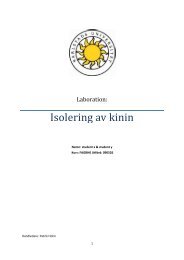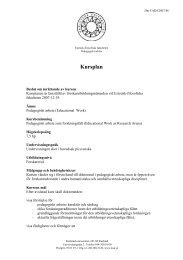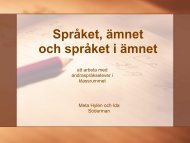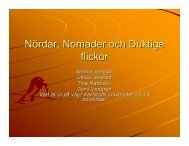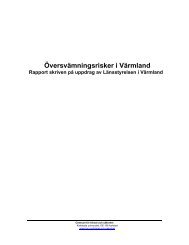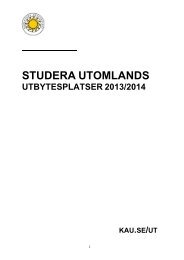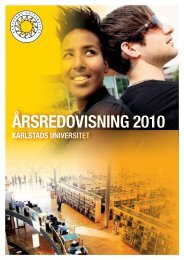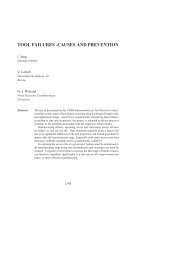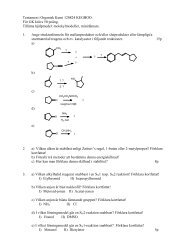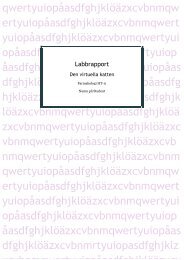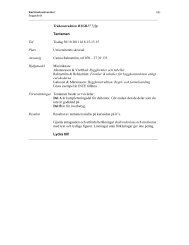CHILDREN'S GESTURES AND THE EMBODIED KNOWLEDGE OF ...
CHILDREN'S GESTURES AND THE EMBODIED KNOWLEDGE OF ...
CHILDREN'S GESTURES AND THE EMBODIED KNOWLEDGE OF ...
You also want an ePaper? Increase the reach of your titles
YUMPU automatically turns print PDFs into web optimized ePapers that Google loves.
GESTURE <strong>AND</strong> <strong>EMBODIED</strong> <strong>KNOWLEDGE</strong> 211This paper is based on a larger study that seeks to explicate embodiedfeatures of children’s mathematical knowing and learning in the elementarygrades. The study was conducted among second-grade students learninggeometry. In this paper, we pay special attention to children’s bodily actions,especially gestures of children’s geometrical thinking. Affiliating with theliterature on the embodiment of mathematical knowledge, we articulate whatknowledge children’s bodily engagements bring forth and how it isconnected to children’s imagination and abstraction in the development ofgeometrical thinking. Thus, children’s knowing that emerges from theirtouching and holding material objects, for example, is irreducible to verbaland written words—touching, taking hold, and gesturing tend to appear longbefore students learn to talk about scientific and mathematical phenomena(Roth, 2001). Knowing and recognizing the sound transcribed as “curve” isnot the same as knowing what it feels to touch a curved surface or to gesturea curve by means of an extended hand–arm movement. We discusschildren’s bodily actions as a necessary form of engagement for thedevelopment of geometrical concepts and illustrate learning situations withchildren’s gestures and the necessary engagements of children’s bodiesinthe process of thinking geometrical ideas.Bodies-in-Action Are Learning BodiesThere is an established and increasing focus in mathematics educationconcerned with gestures in mathematical situations and classrooms contexts(Goldin-Meadow 2004; Cook & Goldin-Meadow, 2006). Such researchexhibits (a) the situated and interactional nature of gestures in learners’articulation of concepts (Koschmann & LeBaron, 2002), (b) the impact andbenefits of mismatches between speech and gesture on children’s mathematicsproblem solving (Singer & Goldin-Meadow, 2005), (c) the nature ofspontaneous gestures as components of and inputs to conceptual integrationfor mathematical ideas, (d) the role of children’s gestures for bringing outimplicit knowledge, and (e) the gestural support in sense making in sciencelearning and teaching (for an extensive review of the literature, see Roth,2001). Understanding the relationships between speech and gestures, thesestudies show that gestures not only are communicative tools but alsoconstitute forms of reasoning and problem solving. For instance, Edwards(2009) suggests that conceptual blends of imaginary thinking and physicalaction necessarily take place in students’ mathematical problem solving andgestures instinctively emerge during those blends. Gestures, bodily experiences,and words are but different, one-sided expressions of the mathematicalconcepts that they metonymically denote (Roth & Thom, 2009a).
GESTURE <strong>AND</strong> <strong>EMBODIED</strong> <strong>KNOWLEDGE</strong> 213their thinking, interacting, and coping with complex ideas of geometry.We observed children’s gestures and interactions in second-grademathematics classrooms in a Canadian public school. The school islocated near the university and enrolls 430 students. These students comefrom ethnically, economically, and academically diverse backgrounds.The school is composed of 17 classrooms of K-5 students and offers adual track program of English (seven classrooms) and French Immersion(ten classrooms). This study was conducted in a second-grade classroomin the English program. There were 23 children (10 girls and 13 boys) inthe class. The children tend to speak English as their first language. Thechildren participated in 15 60-min lessons over 4 weeks. The lessonsincluded the curricular topics of three-dimensional objects, patterns, andmovements of the objects. Children were provided with three-dimensionalgeometrical artifacts to provide visual and tangible experiences with theobjects that they observed, touched, sorted, and manipulated (slid, rolled,and stacked) during classroom activities.The regular classroom teacher is a dedicated teacher, who, at the time,was also the school’s vice principal. She is known in the school districtfor her leadership in curriculum and curriculum development as well asher work in evaluating curriculum materials for the BC Ministry ofEducation. This teacher was very interested in children’s development ofmathematical reasoning and welcomes our research team into herclassroom.There were three researchers involved in this study. One researcher, thethird author of the paper, designed the tasks together with the teacher,taught on her own, team taught with the classroom teacher, and interactedwith the children during both whole-class and small-group sessions. Sheused gestures during her lessons to acknowledge this mode of knowingand to encourage children’s own gestures to emerge. However, she didnot, at any time, present any fixed gestures for particular concepts duringher lessons or give children direct instructions to use certain gestures forcertain occasions or concepts during lessons. In this way, the researcheras teacher did not demand but occasioned children’s gestures to emergenaturally and autonomously. The other two researchers (the first andsecond authors) observed and videotaped classroom activities.To capture the dynamics of the children’s bodily engagement andenaction of geometry, we videotaped all lessons. Two video cameras wereused to record lessons and activities. When the teacher’s instructions weregiven to the whole class, only one camera recorded the classroom sceneas a whole while the other camera recorded a group of two children (Jadeand Sonia) to observe close up, any emergence, movement, or develop-
GESTURE <strong>AND</strong> <strong>EMBODIED</strong> <strong>KNOWLEDGE</strong> 215count any gestures if the teacher directly asked children to gesture, whichwas seldom since the teacher intended to occasion the emergence ofgestures naturally in this study. We tracked and documented the incidenceof gestures that were co-emerging with others’ (teacher or peers) gestures.The results of coding in this round are category (a) 65 (34.0%), category(b) 18 (9.4%), category (c) 104 (54.5%), and category (d) none (0%).During the coding, we also looked for gestures that emerged simultaneouslyfollowing the concepts that were explained or discussed by theteacher or peers. The numbers of co-emerging gestures were 24, 6, 10,and none in each category, respectively (Table 2).The frequencies in Table 2 are subject to the following constraints:Some video did not capture all children in a particular scene. Therefore,the numbers do not reflect all the occasions of children’s gesturesthroughout the lessons. Another issue is that we questioned why theincidence of category (d)—gestures accompanying talk not directedtoward others—was not unlike our preliminary expectation. If childrenuse gestures to think, we expected that children would use gestures andtalk alone while engaged in activities of problem solving. We thought thatthese results might be due to the fact that most of the time the childrenwere engaged in interactive activities such as interacting with the teacher,group work, games, and discussions; therefore, opportunities for gesturingwith talking but no communication were seldom seen in this study.Sometimes, we could observe a few scenes that a child seemed to murmurTABLE 2Incidence of gestures in mathematics lessonsCategoriesNo. ofoccasionsNo. of co-emerginggesturesGestures withoutspeechGestures withspeech(a) Gestures with no65 24 out of 65talking and no apparentcommunication purpose(b) Gestures with no talkingbut with apparentcommunication purpose18 6 out of 18(c) Gestures with talking 104 10 out of 104and communicating with others(d) Gestures with talking None Nonebut no apparent communicationwith othersTotal 191 40 out of 191
GESTURE <strong>AND</strong> <strong>EMBODIED</strong> <strong>KNOWLEDGE</strong> 217children’s thinking and knowing, (b) some gestures co-emerge togetherwith peer’s gestures, (c) gestures cope with the abstractness of conceptualunderstanding, and (d) children’s bodies exhibit geometrical knowledge.By showing incidents of children’s gestures closely, these claims addressthe necessary question of how children’s gestures are integral in mentalprocesses of coordination and abstraction of concepts.Gestures that Embody Children’s Thinking and KnowingIn this study, we observed many instances in which children’s gestures(43.4%) emerged in situations where children were not oriented towardothers. This observation prompted us to ask the following questions: Whydo children gesture when they do not orient themselves to others? Whatrole do such gestures play in children’s learning? We do know fromresearch that congenitally blind people gesture when they talk to others,even though they have never seen someone else gesture and even whenthey speak to other blind individuals (Iverson & Goldin-Meadow, 1998).This seems to suggest that gesturing is part of thinking and not just a wayof reading out thoughts to others. The following episode shows anexample from the second-grade classroom in which the children’sgestures emerged with neither speech nor communicative purpose todirectly interact with others. In this episode, we examine how thechildren’s gestures emerged and what roles they played in the learningsituation.EPISODE #1. Prior to this lesson, the children worked in a variety ofother settings in the students generated distinctions about different shapedobjects as well as sorted and grouped three-dimensional objects accordingto several similarities and differences identified by the studentsthemselves (e.g. box shape, ball shape, pyramid shape, tube shape, etc.).In the previous lesson, children learned about movements (i.e. rolling,stacking, and sliding) with manipulating material objects. In this lesson,the teacher starts reviewing the movement of objects and converses withchildren why certain objects move in certain ways. While the students areexplaining why some objects slide and stack and/or roll, the teacher askswhat makes an object roll (turn 01). Then the teacher starts to conversewith the children about different faces of objects (turns 02 and 03). Alice,a second grader, responds to the teacher’s question with gestures of herown (Figure 1.1 and 1.2). She immediately and without speaking makes agesture that expresses rolling (Figure 1.1a and 1.2a) and again bends herright hand and makes a round shape with her hand along with the classroom
GESTURE <strong>AND</strong> <strong>EMBODIED</strong> <strong>KNOWLEDGE</strong> 219a b cdeShe changes her bodily orientation from the teacher to herself and concentrates on her ownthinking of concept and object.Figure 1. 2 The details of gestures and the changes of bodily orientationAlice’s gestures of bending and rolling her hands articulate rolling androundness—this does not mean she has an explicit idea in her mind.Rather, rolling and roundness exist in the capabilities of her hands, which,in producing rolling and roundness, also express the memory of rollingand roundness (Maine de Biran, 1952). When the teacher asks if it is theflat part or some other part that makes things roll, Alice starts moving herhands. She continues to follow the teacher’s word “curve” by expressingthe formation of a round shape with her right hand. To think through whatmakes things roll, Alice uses both hands to gesture a three-dimensionalobject. Here, “thinking-through” exists in the movement of her hands, andwe have no evidence that any form of verbal thought accompanies thisform of thinking. It is certain that the object concept that has the shape ofa cylinder is in her hand: She literally has her hands on the concept. Hergestures emerge through interactions with the teacher and peers. Thinkingis handwork, according to the German philosopher Martin Heidegger(1982): “Man does not ‘have’ hands, but the hand embodies the nature ofman, because the word, as the realm of the hand, constitutes the nature ofman” (p. 119, our translation). Thus, in Alice’s gestures, we see thinkingas handwork literally occurring.Given that there are may be discrepancies between children’s thoughts,words, and gestures (Goldin-Meadow, Wein & Chang, 1992), we cannotassure that what Alice’s gestures expressed was actually a cylinder. Norcan we make an assertion that her gestures presented that she understood
220MIJUNG KIM, WOLFF-MICHAEL ROTH <strong>AND</strong> JENNIFER THOMthe relationships between rolling and curved face. In fact, Alice’s gestureswere not straightforward to the teacher’s question at some points. Forinstance, she did not make a gesture of a curved face when the teacherasked what makes things roll and if it is a flat face or something else.Instead, she rolled her hands. Yet, even though her gestures were not theexact answers to the question, we can surmise that Alice was processingwith her body what is relevant to the concepts: the relationship betweenroundness and rolling. To develop conceptual understanding, a child putsindividual elements and encounters into groups of the un/related and dis/connected in their thought process, which is called the emergence ofcomplexes (Vygotsky, 1986). Building complexes is a preliminaryprocess for the development of concepts. Alice’s gestures show thatcomplexes of relationships or connections among ideas started emergingin her body. In/through her gestures, the complexes of what makes thingsroll is a curved face, not a flat face was emerging. She later develops around-shaped object in relation to concept of rolling (Figure 1.2). In thisprocess, gestures were essentially engaged in the development ofcomplexes and concept of rolling.The change of Alice’s orientation is another important aspect of bodilyengagement in embodied thinking. When the teacher asks Molly toanswer the question, Alice responds to the situation by her own gesturingand body orientations. She starts gesturing, looking at the teacher, thenshe changes the orientation of her body from the teacher to herself andcontinues to gesture (Figure 1.2). Her gestures articulate embodied formsof thinking-through and conveying the response to the teacher’squestions, and later, her embodied thought process continues withoutmuch relation to the speech. She gestured another round shape (cylinderlike)instead of a sphere that the teacher mentioned. Alice explored ideas,in and through her body movements, concentrating on imaging a threedimensionalobject with curved sur/face. In the process of imaging on herown, her body orientation changed and her hands were more activelyengaged in thinking. Her body was silent but active to process ideasanalogically, in and through her body, and to give shape to conceptsarticulated in the situation. At this moment of her thinking and learning,her body was more centrally present than any verbal or written inter/action.From this episode, readers can learn how children’s bodily movementsare actively and necessarily engaged in building geometrical complexeseven before and without verbal expressions. The body is the expressionand thought, and it was more present than speech in Alice’s knowing andknowledge. Alice’s gestures express her bodily forms of knowing, here
GESTURE <strong>AND</strong> <strong>EMBODIED</strong> <strong>KNOWLEDGE</strong> 221nonverbal but active and for herself rather than in the shared public spaceof the whole-class interaction. To cope with the learning moment,children’s bodies are necessarily aspects of thought, different fromthoughts in the mind, but still expressions thereof. It is precisely thisform of thought that anything mental requires as its base (Maine de Biran,1952).Gestures that Co-emerge with Peers’ GesturesOur study shows that children’s gestures co-emerge through sharedorientations and interactions in the classroom. Some gestures (36% ofgestures without speech and 9.6% of gestures with speech) were coemergingwith gestures when concepts were articulated for others. Evenwhen children were not talking, there were many occasions of coemergentgestures. For instance, in one small-group discussion, we foundchildren attempting to explain to peers the differences between atriangular prism and a rectangular prism. Before this lesson, the studentshad explored two-dimensional shapes as wells as the standard names forthem such as square, rectangle, triangle, and circle. Mark articulates anidea about triangular prisms for the benefit of his classmate, Brad. Theysit facing each other. While explaining, Mark gestures a triangular shapeusing both hands. He puts the two thumbs together signifying thetriangle’s base and the rest fingers attached signifying the other two sidesof the triangle. Then he raises his hands up, retaining the handconfiguration. Without talking, Brad simultaneously makes gestures thatcorrespond to Mark’s talk and gestures. With his right hand, he draws atriangle in a lower position and some straight lines up from it in the air.His gestures are seen to convey the same content as Mark’s speech.However, Brad’s gestures may not have the purpose of conversationalcommunication, since the gestures emerged almost simultaneous withMark’s. What does the co-emergence of Brad’s gestures suggest in termsof embodied learning? We suggest this answer: The gestures express“once-occurrent uniqueness or singularity cannot be thought of, it canonly be participatively experienced or lived through” (Bakhtin, 1993, p.13). Being situated in classroom communications, children participativelyand live through the shared production of concepts, which, as any higherordercognitive form, initially exist in and through social interaction(Vygotsky, 1978). The shared boundaries of learning environmentsdevelop the connectivity of knowing at collective levels. Children’sgestures as embodied cognitive action are situated and contingent, relatedto the way children relate to others, to things, and to themselves. To
222MIJUNG KIM, WOLFF-MICHAEL ROTH <strong>AND</strong> JENNIFER THOMdiscuss these notions more in detail, we illustrate a case of co-emerginggestures through learners’ interactions in the following Episode #2.EPISODE #2. In previous lessons, the children developed relationshipsbetween the attributes of objects (cube, prism, pyramid, cylinder, andsphere) and their movement(s) (slide, stack, and/or roll). The challenge ofthis lesson was for the children to predict and justify what the objects’movement(s) might be when they set on an incline plane. The childrenworked in small groups and explain as well as justify which objects theythought might slide or roll down the incline plane without handling theobjects. In the earlier part of the lesson, the teacher talked about corners(vertices), faces, and edges. At this point, the children still use these termsincorrectly, for instance, as seen in this episode, they used the word“point” to denote an edge.The teacher comes to Jade and Sonia and asks what will happen whenthey put a rectangular prism down the plane. This question challenges thechildren to think through the relationship between the movement andshape through one particular object. Jade, who is standing beside Sonia,responds to the question. Without showing the real object, Jade needs toexplain what would happen to the rectangular prism when it is sent downthe incline plane. She says it will slide because the faces of the object areflat. As Jade explains this, she also uses her hands to gesture, articulatingthe shape of a flat base and a point on the top of a rectangular prism. Sheopens both of her palms horizontally and then joins them together andmakes a shape of an angled hill (Figure 2a, b). She continues by sayingthat curviness cannot make objects slide. At this point, she bends bothhands, putting the right hand in an upper position and her left hand on thedesk (Figure 2c). By joining her flat palms together in an angled position,she explains how the characteristics of rectangular prism—i.e., theflatness of the bottom face—would make the object slide. In this episode,she thinks through the difference between flatness and curviness andexpected movements.Through verbal and gestural responses, Jade expresses the shape of arectangular prism. Here, geometrical thought is not abstracted but existsin and through tactile and kinesthetic actions and imagination. Theseallow children to develop their own images of shape and motion. It isprecisely because geometrical thought is not abstracted that children canlater “apply” in the real world any geometry word: It is only whenchildren are taught words without accompanying bodily experiences thatgeometrical words make no sense to them. Based on these ideas, wefurther question how a child without speech coordinates geometrical ideas
GESTURE <strong>AND</strong> <strong>EMBODIED</strong> <strong>KNOWLEDGE</strong> 223through gestures in interactive classroom situations. In this way, wedevelop a better understanding of the role of gestures in coordinatingideas. In this episode, we investigate more closely Sonia’s responses.While sitting next to Jade, Sonia also begins to gesture. While Jade talksand makes the gestures of flatness, pointy part, and curviness of shapes,Sonia also produces the corresponding gestures.Sonia, without actually speaking, succeeds in coordinating the imageof shapes by means of gestures. While Jade is speaking and making agesture of a surface without curvature, flattening her both palmshorizontally, Sonia attaches her palms together vertically (Figure 2a).When Jade says “it gets a point” while making a point by putting herhands together in an acute angle, Sonia stretches her right hand and sticksout the right thumb and then wraps it with her left palm as if she wantedto distinguish the sticking-out thumb (Figure 2b). For the curved face,Jade bends her right hand and Sonia bends and folds her hands together01 Helen: Because it’s flat[((Helen makes a flat face with her two hands))][((Sarah puts her hands together palm topalm))]02 Helen (continues): and it gets a point.[((Helen makes a triangle shape to express anedge of prism with her two hands))]a[(( Sarah sticks her right thumb out and puts herleft palm around the right thumb))]03 Helen (continues): If it’s curved, then it’s justgoing like this.[((Helen draws a curve moving her hand andlater rolls her hand down))]b[((Sarah makes a curve shape with her twohands))]Figure 2.Sonia’s co-emerging gestures in group interactionc
224MIJUNG KIM, WOLFF-MICHAEL ROTH <strong>AND</strong> JENNIFER THOM(Figure 2c). In her gesture, Sonia expresses flatness, curviness, and theangled part of object that can be seen as an edge. During the entireprocess, Sonia does not speak. She only orients her body toward theteacher and moves her hands to respond to the situation. Through herhands, the shapes of objects are made present—made present again,represented—which exhibits a bodily form of thinking. While nobody cansee into her mind, such bodily forms in fact are all that human beingshave available to communicate (about) geometrical concepts. It is only ina highly idealized world that space—and therefore geometry—is prior toand therefore independent of (the objects of) human experience in theway both Kant (1956) and Piaget (1970) thought.During this process, it is important to notice that even if Jade and Soniaresponded to the same question, their ways of responding differed. Thismeans that Sonia is actually coordinating other possible thought formsrather than acting without thinking. Sonia’s gestures are creative andimmediate actions to connect her to the moment. She is not a passivelistener, but active and engaged in abstraction of the relationship betweenthe shape and movement of a certain object, which Bakhtin (1993)explains as participative thinking. In the nature of participation, thinkingis nonlinear and emergent, and thus, gesturing cannot be a simple copy ofsomebody else’s or representation of learned symbols. The bodyparticipates in abstracting the ideas unfolded in the interaction imaginativelyand spontaneously. Therefore, Sonia’s gestures could co-emergewith Jade’s, not as mimicking but as creative presentations of her ownknowing. From this instance, we may conclude that geometrical thoughtinvolves children’s gestures as real-time actions of imagination tocoordinate geometrical meanings.The nature of mathematical activity is collective as well as individual.Vygotsky (1997) argues that any function of a child’s thought developmentfirst appears in interaction with others. That is, before we can thinkgeometrical ideas in private, we have already encountered in public thepossibilities for certain images and verbal thought forms. Through thesocial and individual abstraction and reflection, mathematical meaningsemerge collectively among learners. And with the intersubjective,interactive nature of learning, children’s gestures co-emerge as childrenarticulate themselves for the purpose of articulating for others. Theepisode reveals that the shapes emerge in and through social interaction.The emergent nature of imaginative, physical actions is possible whenlearners are situated and embodied in interactive and collective situationswhere the outcomes of interactions are neither linear nor predictable. Jadeand Sonia’s bodies are orienting in the same way, physically (in space)
GESTURE <strong>AND</strong> <strong>EMBODIED</strong> <strong>KNOWLEDGE</strong> 225and metaphorically (toward the mathematical object). The children’sbodily movements synchronize to follow the ideas that unfolding in frontof them in the once-occurrent here and now of the present lesson. Beingsituated in the shared situation, their bodily orientation (face, eyes, andupper bodies), speech, and gestures are indistinguishable from theirthinking and knowing. Immediately responding to the situation by pairingwith Jade’s speech and gestures, Sonia’s body is oriented to and coupledwith others. None of these bodily inter/actions can be understoodindependently of thinking and learning in this situation, and thinkingand learning cannot be understood independently of the interactions.Children as interactive learners create intersubjective, collective consciousness,which brings forth shared bodily orientation and participationand the emergence and connectivity of knowledge among learners (Horn& Wilburn, 2005; Roth, 2007). In other words, intersubjective knowingemerges whenever individual learners reciprocally assimilate the actionsof the other in socially interactive situations (Steffe, 2003). Jade andSonia’s gestures in this episode are evidence of the emergence of bodilyand imaginative communication, which is inherently collective andcreative.Gestures that Cope with the AbstractConceptions evolve from and exist in and through primary experiences asthey become connected and mutually mediate and stabilize one another(Roth & Thom, 2009a). This is so because the relation between cognitionand the world presupposes an interlacing that can only be achieved in aliving body, in the flesh (Merleau-Ponty, 1964). Any practically relevantconception exists in and through embodied forms. If it were not like this,we would not know that a particular sensation is related to a geometricalconcept, on the one hand, and we would not know how to act in the worldif our geometrical understandings were to be pure thought. Based on herintuitive understanding of this idea, the teacher provides the children withopportunities to experience three-dimensional objects by sensual means.Through the experiences, the teacher provides the children withopportunities to develop their knowledge of geometrical objects invarious modes such as the language of objects (e.g. rectangular pyramid,sphere, etc.), diagrams or figures (drawings of objects), and classificationsof material objects (grouping). In this process, the children are expectedto relate different ways of knowing to one object, for example, a cube ontheir hands, the diagram of cube drawn on paper, and the sound that istranscribed in the conventions of the International Phonetics Association
226MIJUNG KIM, WOLFF-MICHAEL ROTH <strong>AND</strong> JENNIFER THOMas “kju:b”, but which English speakers here as an instance of the word“cube”. To help students connect their experience of three-dimensionalobjects to other forms of representations, the teacher engages them invarious activities of naming and name-making, grouping and matchingcards of names or diagrams, and explaining physical demonstrations withor without material objects. During activities, the teacher also challengeschildren to provide cards of objects that they have not seen in threedimensionalform. This allowed the research team to observe howchildren’s gestures were engaged to cope with a new and abstractsituation. Throughout children’s problem solving with those challenges,an ongoing cycle of embodied learning took place in the dynamic balanceof different forms of knowing. In other words, to understand and solve anew, abstract task, children had to integrate their knowledge andexperiences of objects and also applied them into an unknown situationwith creative imagination.In this study, we come to understand that for the abstraction ofgeometrical objects, the children’s bodily activities became grounds forconstituents of reflecting on geometrical concepts. For children, gesturingwas a way of coping with the challenge of unknown objects and ofbringing forth a dynamic balance of abstracting and acting on learningconcepts. When children encountered new ideas, their gestures wereemerging and organizing their thinking in visible and concrete dimensions.In observing this process, we have no evidence for the separation ofthinking and communicating, which are two processes that in fact appearto mutually stimulate each other (Vygotsky, 1986). As the conceptsbecome more abstract and complicated over time, children’s handmovements also embody the complexity of thinking and expressing overthe concepts. The following Episode #3 shows an example of children’sgestures in the process of thinking in a new situation.EPISODE #3. To understand the relationships between the types of facesand the movements of objects, children participated in various tasks. Theylearned the different parts of objects (faces, vertices, edges, etc.) and theprocesses of rolling, stacking, and sliding. They observed these processeswith real objects. They predicted which objects would roll, stack, andslide, and they explained their rationale behind their predictions. Theyalso made their own names and learned standard geometric names forfigures of material objects. In this episode, children are expected toexplain the relationships between geometrical objects and their associatedmovement(s) (rolling, stacking, and sliding) by applying their conceptsthey already learned.
GESTURE <strong>AND</strong> <strong>EMBODIED</strong> <strong>KNOWLEDGE</strong> 227In this situation, the children are playing a card game that requiresthem to name objects on cards and explain their thinking of how an objectwould move without manipulating real objects. About 15 cards weregiven to each group of children. Each card contains a drawing of differentgeometrical objects. Most of objects were observed and tested in theprevious classes with artifacts. However, there are also several newobjects such as a hexagonal prism, an ovoid, and a half sphere thatchildren have not investigated previously. When it is Jade’s turn, shepicks up a card and flips it. She looks at the card featuring a half sphereand she says, “Can it roll? Actually, it can roll and slide.” Jade startsexplaining by using her hands. She shows how the object would slide(turn 01, Table 3) as well as roll (turn 02). However, Sonia does not agreewith Jade (turns 03–07). Sonia starts explaining her ideas with gestures.When Sonia and Jade are challenged by the object that they have notseen before, their knowledge about relationships of shape and movementis reflected to the newness of the object. Their gestures seem to becomeTABLE 3Sonia and Jade talking about half sphereTurnVerbal and gestural interaction01 Jade: If you put this way, it’s gonna all slide, [((Jadeslides her hand))]02 but if you put on that part, it’s gonna start rolling likethis [((Jade rolls her hand))]03 Sonia: Jade, you know what?04 With this, it couldn’t roll because roll,05 it goes, it repeats. [((Sonia rolls her hands on the desk))]06 And this one, it can’t because it’s roll for a part07 [((Sonia twists her hands once))]and then the face that is flat goes and stops. [((Sonia rollsher hands once and stops the movements))]08 Jade: But the bottom side, it would slide09 but this side, it would roll because it is part of sphere.10 Sonia: Yes, but it’s a half so it’s flat in the middle, and it’scurve. [((Sonia moves her hands as if she cut an object in half))]11 If you roll it, it will stop because it will go,12 so it’s like this, [((Sonia rolls her hands))]13 If you roll it like this, it will go one time, [((Sonia puts her twohands together and makes a bowl-like shape and slantsher upper body as if her body moved along with the object))]14 then it will stop.[((Sonia’s body gets more slant and stops moving))]
228MIJUNG KIM, WOLFF-MICHAEL ROTH <strong>AND</strong> JENNIFER THOMcentral in the effort of coping with the abstract image. To think throughthese new ideas, Sonia uses gestures—much like James Watson andFrancis Crick were moving about cardboard shapes to think through ideasabout the structure of DNA. Sonia first explains that rolling meansrepeating (turns 04–05), crossing her right hand over the left hand(Figure 3a). Then she starts to explain why she thinks that a half spheredoes not roll by talking about a flat face. She puts her two palms down tothe desk first and then puts her left hand on the desk vertically and movesher right hand from up to down as if she was slicing something on verticalline (Figure 3b, c). To convince Jade, who does not agree with her easily,Sonia elaborates her explanation by adding more gestures (Figure 3d–g).She explicates the relationship of a flat/curved face and the movements itenables. Together with her talking, she makes gestures of twisting androlling with her two hands and arms (Figure 3d). Then she curves andjoins her hands to make a bowl-shape figure (Figure 3e), and she startsmoving her joined hands, arms, and her upper body as if she were holdingthe object and moving along with it (Figure 3e, f). When the object stops,her body also stops moving (Figure 3g). With the gestures, Soniaarticulates why a half sphere cannot roll. The nonpresent object takes on avirtual presence in her bodily movements.The development of Sonia’s gestures in this episode exhibits thecomplexity of Sonia’s thought in a new situation. In and through hergestures, she is organizing and presenting her thoughts in visual form.a (turn 04, 05) b (turn 6,7) c (turn 10) d (turn 11)e (turn 12) f (turn 13) g (turn 14)Figure 3.Sonia’s explanation of a half sphere
GESTURE <strong>AND</strong> <strong>EMBODIED</strong> <strong>KNOWLEDGE</strong> 229Because translation means treason, it would be inappropriate to saythat these thoughts also existed in verbal form unless there is explicitevidence for such forms to be present and relevant. When she facesthe novel object, that is, the half sphere, she mobilizes bodilyknowledge of rolling, of which curvy face rolls and flat face goesand stops. To argue for her ideas, she evolves accurate and logicalforms of gestures of half sphere and its movement and helps Jadeunderstand that a half sphere cannot roll. Sonia features the shape andmovement of the object with her hands as if she were holding andmoving material objects. Sonia coordinates, anew, between two faces(curve and flat) and two motions (rolling and not rolling) that arealready known to her (e.g. curve and rolling), which leads to ananticipation about how a body must move (will not roll beyond thehalf ball part of it). Without operating on the real object, she stillsolves the problem in a visual manner. Her gestures emerge to reflectideas in this new situation. Her thinking develops in and through hergestures, and her gestures further develop her thinking. Her gesturesconstitute the thinking with and about shapes and motion.Geometrical Knowledge in Children’s BodiesAs the geometrical concepts became more complex along the course, thechildren’s gestures also became integral and more complex. Thus, at thebeginning of the study, children’s gestures were simple and fragmented.They used gestures disjointedly to explain ideas such as round, flat, orroll. For example, they bent or rolled their hands once in the context ofwhich sphere could roll, neither stack nor slide because it did not haveany flat faces. Later, children’s gestures developed to cope with complexrelationships between concepts. The development of Sonia’s gestures inthe Episode #3 is an example of this idea. Before Sonia encountered thechallenge of half sphere, the task was to answer what rectangular prismswould do. Sonia earlier explained that a rectangular prism would slidebecause it had all flat faces. She also explained what rolling meant. Tosolve the problem of half sphere, Sonia was connecting the concepts ofcurve and flat and rolling and sliding (see Table 4).These data indicate that Sonia coordinates, in a new way, two faces(curved, flat) and two movements (rolling and sliding) that were alreadyknown to her. This led to a novel anticipation about how the half spherewould move (will not roll beyond the half ball part of it). In and throughher body, she articulates for herself as much as for others that rollingneeds to repeat without stopping and flat face does not make things roll.
230MIJUNG KIM, WOLFF-MICHAEL ROTH <strong>AND</strong> JENNIFER THOMTABLE 4Conceptual development through speech and gestureTurn Sonia’s speech Sonia’s gesture Possible concept05 it goes, it repeats. She rolls her hands. Roll means06 And this one, it can’tbecause it’s roll for a partShe twisted herhands once.to repeat.07 and then the face that isflat goes and stops.She rolls her handsand stops the movements.Flat face doesnot roll.10 Yes, but it’s a half so it’sflat in the middle, andit’s curve.She moves her hands asif she cut an object in half.A half spherehas a flat facein the middle;11 If you roll it, it will stopbecause it will go,12 so it’s like this, She puts two hands togetherand makes a bowl shape.13 If you roll it like this, She moves her body as if sheit will go one time, was holding a half sphere.14 then it will stop. Her body stops moving.therefore, itcannot roll.Therefore, she explains that a flat face on half sphere does not allow theobject to roll but that it will stop at some point. Each individual gesture(e.g. round, flat, rolling, sliding) is combined in the ideas of threedimensionalobjects (e.g. sphere, rectangular prism) and further in therelationships among object, shape, and movement (e.g. sphere-roundface-rolling and rectangular prism-flat face-sliding). The child’s gesturestherefore constitute and exhibit a form of conceptual development (seeFigure 4).There have been suggestions that children have the ability of formingmental images in their abstraction of concepts and they actually processmental operations of those images to solve mathematical problems given(Steffe, 2002). But anything that may occur in the privacy of our mindsinevitably is the result of social relations (Vygotsky, 1978). What thechildren in our study might do in private and inaccessible to observationinevitably has arisen from the ways in which they have related to others.These ways always are public and available to the senses—no educator orpsychologist would use extra sensory perception and communication as avalid explanation of learning. As Sonia articulates the movements of a halfsphere that she had never seen or touched before, imagining is enactedwitnessably in and through her body movements. Her body developed andembodied the geometrical concepts (shape and movement).
GESTURE <strong>AND</strong> <strong>EMBODIED</strong> <strong>KNOWLEDGE</strong> 2313-dimensional objects characteristics of object movementSpheres, cylinder Round faces Rollingprisms (triangular,rectangular, hexagonal)Pyramids (triangular,rectangular, hexagonal)Flat faces, edgesPointy tops (apex)Sliding, StackingSlidingRoundness-RollingFlatness-SlidingFlatnessslidingSphere Rectangular prism PyramidTask: how will half spheres move? Roll? Stack? Slide?halfsphereFlatness & roundness sliding? Rolling? Bodily coping andproblem solvingFigure 4.The relationships among characteristics, shapes, and movementOur video materials show how children actively think and learn therelationships of objects, shapes, and movements in and with their bodies.Without doubt, the neurons of the mind are somehow involved. But whatmatters to mathematics educators is what children such as Sonia makeavailable to others, and these are body movements, hand and armgestures, and words. There is nothing abstract about concepts if werecognize how they are constituted across these varying bodily expressions.There is no need to draw on theories of the invisible, no need forinaccessible mental images and schemas, as everything required forcommunicating concepts and solving problems is enacted and madeavailable by bodily means. There is no doubt that Piaget overintellectualizedknowing (Merleau-Ponty, 1945/2002; Varela et al.,1991) and thereby merely reified another metaphysical theory of knowingthat is of a different matter than the material of this world. Once weaccept the embodiment hypothesis, we are actually in a position toappreciate that mathematics emerges “as meaningful structures for usmainly through the bodily experience of movement in space, manipulationof objects, and perceptual interaction” (Núñez et al., 1999, p. 51).The patterns of mathematical encounters order children’s perceptions,
232MIJUNG KIM, WOLFF-MICHAEL ROTH <strong>AND</strong> JENNIFER THOMconceptions, and actions and the whole process of cognitive experiencesexpand children’s dynamic articulation of mathematical concepts.RETHINKING KNOWING <strong>AND</strong> <strong>KNOWLEDGE</strong> IN <strong>EMBODIED</strong> LEARNINGThis study was designed to investigate how children’s bodily experiencesunderpin their knowing and learning of geometrical concepts said to be tooabstract for their age. First, we found that children’s bodies (bodilyorientations and gestures) constitute an integral part of knowing, thinking,and learning supporting the appropriate of geometrical concepts before the agethought possible. Children occasionally used gestures without speech whenthey explored, processed, and expressed their own ideas. We exemplify thesefindings in the study of three children. For example, Alice’s hands, withouttalking, internalize the meaning of concepts (e.g. a round face) through and inher body. Sonia thinks about how objects move in and through her body.When the children encountered new situations, their bodies become resourcesfor actively coping with the problems. As seen in Sonia’s movements,children’s bodily coping brings forth the dynamic, dialectical balance withingeometrical knowledge. Being engaged in abstracting the knowledge ofobjects, gestures become constitutive forms of geometrical knowing.Second, the children’s co-emerging gestures allowed new concepts tobe enacted for themselves and others and, thereby, for new concepts tobecome reflexive objects available to individual and collective inspection.Brad’s and Sonia’s co-emerging gestures in Episode #2 suggest thatchildren’s living, interactive cognition makes possible the emergence ofcollective knowledge in learning situations. As individual sense makingand collective knowledge emergence are co-implicated in interactivelearning situations (Davis & Simmt, 2003), children’s bodies as learningsystems are necessarily embedded in individual and collective ways oflearning geometrical concepts. During the group interaction, the wholescene of co-gesturing became the collective understanding of geometricalobjects among the learners. Because children communicate for others,their actions are also shared: “consciousness-for-myself”, as the etymologicalroot suggests (Lat. con-, with + sciēre, knowing), always is a“practical consciousness-for-others” (Vygotsky, 1986, p. 256). Thereflexive, enactive bodies resonate with intersubjective understanding ofgeometrical concepts among the children. Accordingly, their knowledgeis shared, co-emerges, and co-develops. In other words, their knowledgegrows through their connected, interactive bodies and minds in theenvironments where they are situated. This study highlights that
GESTURE <strong>AND</strong> <strong>EMBODIED</strong> <strong>KNOWLEDGE</strong> 233children’s bodily movements are cognitive actions to orient and processthinking and knowing of geometrical concepts. The body as the lynchpinof thinking and knowing concretizes, reflects, and embodies the livedexperiences and interactions of shapes and movements of objects. As thechildren’s bodies are bounded together with the objects and phenomena infront of them, their imagining and reflecting on them are also situated,intersubjective, but in creative ways.Requestioning of the scheme of body is indeed relearning of ourknowledge of the world “as we are in the world through our body and weperceive the world with our body” (Merleau-Ponty, 1945/2002, p. 239). Therecognition of the body in one’s thinking and knowing of conceptschallenges the received views of knowledge in learning and teaching.Knowledge development is not a result of some invisible construction butthe result of social relation. Knowledge only exists as it is expressed in andthrough action. This further emphasizes that knowledge is not in verbal andwritten languages alone but also bodily actions as seen in which children’sbodies embodied and presented the shape and movements of objectssometimes without speech. Sonia’s knowing of half sphere cannot bereduced to only her speech. Her knowing and knowledge exists also throughand in her gestures. Embodied cognition suggests whatever we recognize asrational, scientific, or mathematical is fully embedded in our bodily actions(Nemirovsky & Ferrara, 2009). This notion of embodied knowledgechallenges received ways of theorizing mathematical and scientific knowingwhich have missed important aspects of practical, bodily thinking in theprocess of concept development. When knowing takes place fromcoordination of mental and bodily interactions among learners, knowledgeneeds to be understood and developed in and through those interactions. Thisapproach allows us to rethink knowledge in terms of consciousness, whichinherently is consciousness with and for others.Despite two decades of research on the embodied nature of cognition,constructivist perspectives continue to emphasize abstraction of knowledgefrom the physical engagement with the world (e.g. Battista, 2007; Mulligan,Mitchelmore & Prescott, 2005; Outhred & Mitchelmore, 2004) andinessence a theoretical articulation of metaphysics. In this way, constructivismorients our attention away from the body, concerned as it is with theconstruction of mental entities and representations. In this study, we exhibitthe central role of the body in children’s knowing and learning to encourageteachers and curriculum designers to refocus teaching methods andevaluation/testing. Once we acknowledge the body as the seat of knowledgeitself rather than as a stepping stone to abstractions, it is possible to organizeteaching differently. In doing so, brings forth the possibility of inquiring into
234MIJUNG KIM, WOLFF-MICHAEL ROTH <strong>AND</strong> JENNIFER THOMsuch questions as, “What might we do to recognize and understandchildren’s knowledge expressed in modes other than speech or writing?”Such a question prompts us to look into alternative ways of understandingand promoting children’s learning in classrooms in addition to their verbal orwritten performance as knowledge development. Besides verbal articulation,reports, or answers to written tests, some knowledge of science andmathematics such as modeling, performing, problem solving, or doingpractical work are bodily oriented knowing, whose process cannot bepresented only through verbal and written contexts. For instance, learnerssolve problems in science and math project through bodily interactions suchas designing, drawing, measuring, or manipulating objects. Learners maycarry out practical work to understand the unfolding scientific phenomena infront of them. Much of their knowledge of science and mathematics ispromoted and exhibited through their bodily engagement and movements,not only verbal speech or written products. However, it is not commonpractice for mathematics teachers to pay attention to children’s bodilyengagement as a way of knowing. Rather, assessments are done using formalrepresentational means, and although what students provide on a written testor verbally as a response to a teachers’ questions are certainly ways ofunderstanding students’ knowledge, these forms of assessment are limited inthe opportunities they afford toward understanding the complexity ofchildren’s cognitive development and restructuring forms of teaching andlearning by engaging bodily experiences. As children think, develop, andexpress knowledge through their bodies, their bodily engagement needs tobe realized as integral to student learning. Their bodies are necessarilyengaged in coping with the abstractness of knowledge. Their bodies embodythe knowledge of science and mathematics and become part of knowingitself. Thus, despite the ever-increasing research on embodied knowing,there continues to be a need for developing strategic ways of understandingchildren’s bodily engagement and expression as it exists in classroomsettings as embodied cognition.Throughout this study, we articulate the central roles of children’sbodily engagement, especially gestures in classroom settings. Throughexhibiting the cases of children’s gestures, we substantiate how gesturesplay an integral role in the children’s geometry learning. However, wealso encountered some issues in this study. First, we could not exhibitdistinctive cases to explain how an individual learner used gestures whens/he was involved in problem solving process, which might provide usmore descriptive details of gestural engagement in thinking anddeveloping ideas. Throughout the study, the children engaged in aninteractive mode of learning with talking-out-loud strategies, that is, the
GESTURE <strong>AND</strong> <strong>EMBODIED</strong> <strong>KNOWLEDGE</strong> 235children were required to explain their thinking out loud most of the time,or they played interactive games. In other words, the children engaged inverbal interactions most of times. We designed the lessons in such waysbecause one of the study intentions was to understand children’sembodied cognition in collective learning environments, and therefore,the children seldom worked on tasks alone. This instructional strategymight have limited us to examine in depth how gestures developindividual thinking and cognitive process as children are engaged inproblem-solving tasks without communicating with others. To probe theprocess of cognition developed by gestures, there needs to be furtherresearch to bring forth individual problem solving tasks and interpretchildren’s gestures throughout the tasks over time. And yet, this approachalso needs to be approached carefully with realization of collective natureof embodied cognition. Second, we did not look into children’s gesturesto evaluate their knowledge of geometry in this study. Therefore, therestill remains a challenge that we need to develop pedagogical strategiesfor using children’s gestures to evaluate their knowledge development.When we overcome this challenge, there may be more practice ofengaging and using children’s bodily engagements in classrooms. Futureresearch with teachers might allow us to identify means of evaluation thatare both ecologically valid and feasible within the temporal constraintsthat schooling imposes. But we do know that failing to pay attention towhat learners’ bodies know and present as collective forms of knowing,we may not understand the whole process of children’s thought andknowledge development.AC<strong>KNOWLEDGE</strong>MENTThis research project was supported by several grants from the SocialSciences and Humanities Research Council of Canada. We are grateful toLilian Pozzer Ardenghi who helped us in the videotaping. We want toexpress our gratitude to the second-grade students, their regular teacher,the teacher intern, and teachers on call who assisted us during the weeksof our study.REFERENCESAlibali, M. W., Bassok, M., Solomon, K. O., Syc, S. E. & Goldin-Meadow, S. (1999).Illuminating mental representations through speech and gesture. Psychological Science,10, 327–333.
236MIJUNG KIM, WOLFF-MICHAEL ROTH <strong>AND</strong> JENNIFER THOMBakhtin, M. (1993). Toward a philosophy of the act. Austin, TX: University of TexasPress.Battista, M. T. (2007). The development of geometric and spatial thinking. In F. K. LesterJr. (Ed.), Second handbook of research on mathematics teaching and learning (pp.843–907). Charlotte, NC: Information Age.Beattie, G. & Coughlan, J. (1998). Do iconic gestures have a functional role in lexicalaccess? An experimental study of the effects of repeating a verbal message on gestureproduction. Semiotica, 119, 221–249.Cook, S. W. & Goldin-Meadow, S. (2006). The role of gesture in learning: Do childrenuse their hands to change their minds? Journal of Cognition and Development, 7(2),211–232.Davis, B. & Simmt, E. (2003). Understanding learning systems: Mathematics educationand complexity science. Journal for Research in Mathematics Education, 34(2), 137–167.Edwards, L. (2009). Gestures and conceptual integration in mathematical talk. EducationalStudies in Mathematics, 70(2), 127–141.Goldin-Meadow, S., Wein, D. & Chang, C. (1992). Assessing knowledge throughgestures: Using children’s hands to read their minds. Cognition and Instruction, 9(3),201–219.Goldin-Meadow, S. (2004). Gesture’s role in the learning process. Theory in Practice, 43(4), 314–321.Hadar, U. & Butterworth, B. (1997). Iconic gestures, imagery, and word retrieval inspeech. Semiotica, 115, 147–172.Heidegger, M. (1982). Gesamtausgabe Band 54: Parmenides [Works vol 54: Parmenides].Frankfurt, Germany: Vittorio Klostermann.Horn, J. & Wilburn, D. (2005). The embodiment of learning. Educational Philosophy andTheory, 37(5), 745–760.Iverson, J. M. & Goldin-Meadow, S. (1998). Why people gesture when they speak.Nature, 396, 228.Jordan, B. & Henderson, A. (1995). Interaction analysis: Foundations and practice. TheJournal of the Learning Sciences, 4, 39–103.Kant, I. (1956). Werke Band II: Kritik der reinen Vernunft [Works vol. 3: Critique of purereason]. Wiesbaden, Germany: Insel.Koschmann, T. & LeBaron, C. (2002). Learner articulation as interactional achievement:Studying the conversation of gesture. Cognition and Instruction, 20(2), 249–282.Lakoff, G. & Johnson, M. (1999). Philosophy in the flesh: The embodied mind and itschallenge to western thought. New York: Basic Books.Maine de Biran, P. (1952). Mémoire sur la décomposition de la pensée [Thesis on thedecomposition of thought]. Paris, France: Presses Universitaires de France.Merleau-Ponty, M. (1945/2002). Phenomenology of perception. London: Routledge.Merleau-Ponty, M. (1964). Le visible et l’invisible [The visible and the invisible]. Paris,France: Gallimard.Mulligan, J., Mitchelmore, M. & Prescott, A. (2005). Case studies of children’sdevelopment of structure in early mathematics: A two-year longitudinal study. In H.L. Chick & J. L. Vincent (Eds.), Proceedings of the 29th conference of the internationalgroup for the psychology of mathematics education, Vol. 4 (pp. 1–8). Melbourne, VIC,Australia: PME.
GESTURE <strong>AND</strong> <strong>EMBODIED</strong> <strong>KNOWLEDGE</strong> 237Nemirovsky, R. & Ferrara, F. (2009). Mathematical imagination and embodied cognition.Educational Studies in Mathematics, 70(2), 159–174.Núñez, R., Edwards, L. & Matos, J. (1999). Embodied cognition as grounding for situated andcontext in mathematics education. Educational Studies in Mathematics, 39(1–3), 45–65.Outhred, L. & Mitchelmore, M. (2004). Students’ structuring of rectangular arrays. In M.J. Høines & A. B. Fuglestad (Eds.), Proceedings of the 28th PME internationalconference, 3 (pp. 465–472). Bergen, Norway: Bergen University College.Piaget, J. (1970). Child’s conception of movement and speed. London: Routledge.Pirie, S. & Kieren, T. (1994). Growth in mathematical understanding: How can wecharacterize it and how can we represent it? Educational studies in Mathematics, 26(2–3),165–190.Radford, L. (2009). Why do gestures matter? Sensuous cognition and the palpability ofmathematical meanings. Educational studies in Mathematics, 70(2), 111–126.Rasmussen, C., Nemirovsky, R., Olszewski, J., Dost, K. & Johnson, J. (2004). On formsof knowing: The role of bodily activity and tools in mathematical learning. Educationalstudies in Mathematics, 57(3), 303–321.Roth, W.-M. (2001). Gestures: Their role in teaching and learning. Review of EducationalResearch, 71(3), 365–392.Roth, W.-M. (2003). From epistemic (ergotic) actions to scientific discourse: Do gesturesobtain a bridging function? Pragmatics & Cognition, 11, 139–168.Roth, W.-M. (2005). Doing qualitative research: Praxis of method. Rotterdam, TheNetherlands: Sense.Roth, W.-M. (2007). Communication as situated, embodied practice. In T. Ziemke, J.Zlatev, R. Frank & R. Dirven (Eds.), Body, language and mind (pp. 431–456). Berlin,Germany: Walter De Gruyter.Roth, W.-M. (2009). Mathematical representation at the interface of body and culture.Charlotte, NC: Information Age.Roth, W.-M. (2010). Geometry as objective science in elementary school classrooms:Mathematics in the flesh. New York: Routledge.Roth, W.-M. & Thom, J. (2009a). Bodily experience and mathematical conceptions: Fromclassical views to a phenomenological reconceptualization. Educational Studies inMathematics, 70, 175–189.Roth, W.-M. & Thom, J. S. (2009b). The emergence of 3D geometry from children’s(teacher-guided) classification tasks. Journal of the Learning Sciences, 18, 45–99.Sfard, A. (2007). Thinking and communicating: Human development, the growth ofdiscourses, and mathematizing. Cambridge, MA: Cambridge University Press.Sheets-Johnstone, M. (2009). The corporeal turn: An interdisciplinary reader. Exeter,UK: Imprint Academic.Singer, M. & Goldin-Meadow, S. (2005). Children learn when their teacher’s gestures andspeech differ. Psychological Science, 16(2), 85–89.Steffe, L. (2002). A new hypothesis concerning children’s fractional knowledge. Journalof Mathematical Behavior, 20(2), 267–307.Steffe, L. (2003). Fractional commensurate, composition, and adding schemes learningtrajectories of Jason and Laura: Grade 5. Journal of Mathematical Behavior, 22(2),237–295.Varela, F., Thompson, E. & Rosch, E. (1991). The embodied mind: Cognitive science andhuman experience. Cambridge, MA: MIT Press.
238MIJUNG KIM, WOLFF-MICHAEL ROTH <strong>AND</strong> JENNIFER THOMVygotsky, L. S. (1978). Mind in society: The development of higher psychologicalprocesses. Cambridge, MA: Harvard University Press.Vygotsky, L. S. (1986). Thought and language. Cambridge, MA: MIT Press.Vygotsky, L. S. (1997). The collected works of L. S. Vygotsky, Vol. 4. In R. Rieber (Ed.),The history of the development of the higher mental functions. New York: Plenum.Mijung KimNatural Sciences and Science Education, National Institute of EducationNanyang Technological University1 Nanyang Walk, Singapore, 637616, SingaporeE-mail: mijung.kim@nie.edu.sgWolff-Michael Roth and Jennifer ThomUniversity of VictoriaVictoria, BC, Canada



